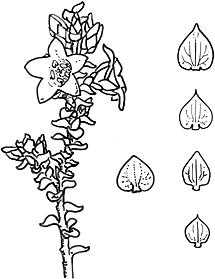Common name: Coast Coral Heath, Coral Heath
Epacris microphylla R.Br. APNI* Synonyms: Epacris microphylla R.Br. var. microphylla APNI*
Epacris longespinulosa Gand. APNI*
Epacris walteri Gand. APNI*

Description: Erect, multibranched shrub to 100 cm high, sometimes to 180 cm; stems with inconspicuous leaf scars; branchlets villous.
Leaves usually erect to subreflexed, sometimes upwardly appressed, ovate, rhombic or sometimes ± circular, 2–6 mm long, 1.5–4 mm wide, apex acute to acuminate, base usually cordate, margins ± scabrous; lamina ± thick, usually concave; sessile or petiolate to 1 mm.
Flowers solitary but extending down branches to form leafy inflorescences, 4–6 mm long, 1.5–4 mm wide, white often pink-tipped in bud; peduncle 0–4 mm long; bracts acute. Sepals 2–3.5 mm long. Corolla tube 1.5–3 mm long; lobes 1.6–3.5 mm long. Anthers obvious in throat.
Fruit a dry capsule, 2 mm long.
Flowering: Throughout year but mainly July–November
Distribution and occurrence: Widespread from the coast to c. 1900 m alt. In swampy heath, also in drier coastal heath and in dry sclerophyll forest on sandstone and granite.
NSW subdivisions: NC, CC, SC, NT, CT, ST, NWS, SWS
Other Australian states: Qld Vic.
ECOLOGY
Life History
Vegetative spread No.
Longevity 5--20 years (D. Keith pers. comm.).
Primary juvenile period 5 years (Keith 1996).
Flowers White, at any time of year.
Fruit/seed Capsule, 2 mm long, average seed weight 0.03 mg (J. Howell pers. comm.).
Dispersal, establishment and growth Diaspore: seed, no special dispersal morphology (Westoby et al 1990). Soil-stored seedbank. Recruitment mainly after fire (D. Keith pers. comm.).
Fire response Killed (Morrison et al. 1995), killed by fire, seedlings noted after high intensity fire (at Lane Cove & Narrabeen Lake 1/1994), flowering within 2 years (P. Kubiak pers. comm.).
Interaction with other organisms Shoot damage by rabbits but not eaten (P. Kubiak pers. comm.).
Habitat
Habitat Heath--woodland on poor soils.
Altitude 0--1000 m
Annual rainfall 900--1600 mm
Typical local abundance Frequent.
Vegetation Dry eucalypt forest e.g. with Eucalyptus haemastoma; heath e.g. with Banksia spinulosa, Banksia serrata, Acacia myrtifolia, Acacia suaveolens.
Substrate Sandy soils, with clay influence? on sandstone, low-nutrients, periodically wet.
Exposure LIght shade--full sun.
ECOLOGY
Life History
Flowers White, October--March.
Fruit/seed Capsule, 2 mm long, March--June.
Dispersal, establishment and growth Diaspore: seed.
Habitat
Habitat Rock crevices, creekbanks.
Altitude 600--1200 m
Annual rainfall 900--1400 mm
Typical local abundance Frequent.
Vegetation Sphagnum bog, shrub swamp.
Substrate Rocky creek banks, sandstone crevices, peaty bog on granite, low nutrients, permanent moisture.
Exposure ? Full sun.
APNI* Provides a link to the Australian Plant Name Index (hosted by the Australian National Botanic Gardens) for comprehensive bibliographic data
***The AVH map option provides a detailed interactive Australia wide distribution map drawn from collections held by all major Australian herbaria participating in the Australian Virtual Herbarium project.
|


